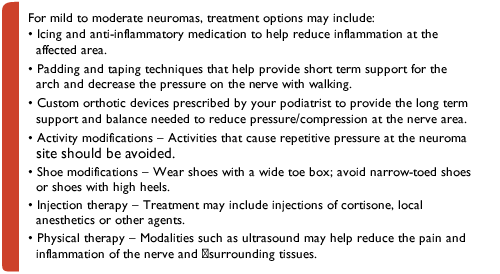Do You Have
Morton’s Neuroma?
Joel Kowski, DPM, FACFAS
Podiatric Medicine
Foot & Ankle Clinic
Menomonie
Do you have the feeling that something is under the ball of your foot while wearing your shoe? Or, does your sock feel like it is bunched up? Do you have sensations of pain, burning, tingling or numbness at the base of your toes? Are these symptoms temporarily relieved by removing your shoe and massaging your foot? If this sounds familiar, you may have a Morton’s neuroma.
The symptoms of a neuroma often begin gradually.
At first, they may occur occasionally when wearing your favorite narrow-toed shoes, or performing certain activities.
Over time the symptoms progressively worsen and may persist for several days, weeks or even months. The symptoms then become more significant as the neuroma enlarges and damage to the nerve becomes permanent.

What Causes a Neuroma?
Compression or irritation of the nerve leads to the development of a neuroma. One of the most common causes is wearing tight, narrow shoes that have a tapered or narrowed toe box. Also, high-heeled shoes that cause the toes to be forced into a narrow toe box.
In addition, people with certain foot deformities have an increased risk for developing a neuroma. This includes bunions, hammertoes, flatfeet and high-arched feet. Other contributing factors may include sports or work related activities that involve repetitive irritation to the ball of the foot.
When do I Consult a Podiatrist?
If you think you may have a neuroma, seek medical attention. It is best to see your podiatrist as early in the development of these symptoms as possible. Early diagnosis and treatment greatly lessens the need for more intensive treatment and may help avoid surgery. Your podiatrist/foot and ankle surgeon will obtain a thorough history of your symptoms and perform a physical examination of the foot. During the examination, the doctor may attempt to reproduce your symptoms by manipulating your foot. Other tests, such as x-ray or MRI may also be needed to aid in diagnosis, and rule out other possible causes of your pain.
Non-Surgical Treatment Options
When developing a treatment plan, your podiatrist will consider how long you’ve had the neuroma, and evaluate the severity of symptoms.

If Surgery is Required
Surgery may be required for patients who have a severe enlargement of the nerve, or have not responded adequately to non-surgical treatments after several weeks. Surgery typically involves release
of tissues that may be irritating the nerve, or removal of the damaged/enlarged section of nerve. Your podiatric foot and ankle surgeon will determine the approach that is best for your condition. The surgery is performed as an outpatient. While under intravenous sedation, the patient is given local anesthesia to numb the area.
The length of the recovery period will vary, depending on the specifics of the procedure performed. Typically, there would be several weeks of limited walking to protect the surgical area, keeping pressure off the ball of the foot by using a special post-operative shoe or crutches. This is followed by a progressive return to normal footwear and activities over a period of several weeks.
Dr. Kowski is board certified in foot surgery by the American Board of Podiatric Surgery, and is a Fellow of The American College of Foot and Ankle Surgeons.
Dr. Joel Kowski – Foot & Ankle Clinic
For information or to schedule an appointment:
715.235.4274 | 800.359.4421 | www.oakleafmedical.com
Dr. Kowski sees patients in Menomonie, Baldwin, Durand, Eau Claire, Neillsville, Rice Lake and Stanley.




